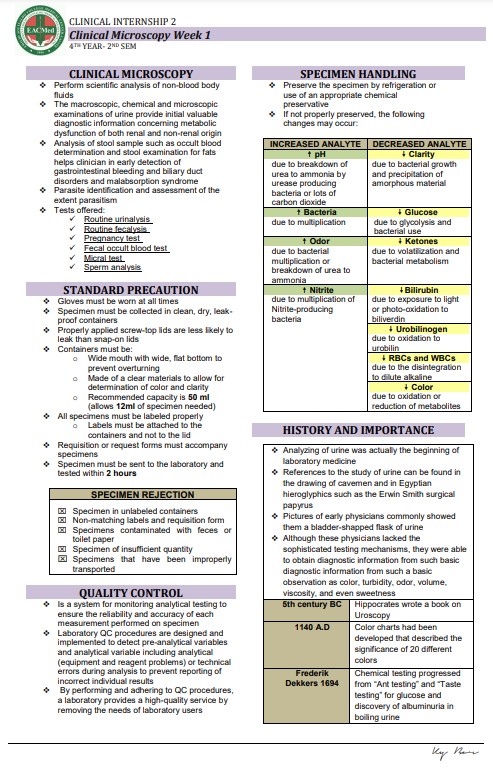Clinical Microscopy for Body Fluids Analysis
Summary:
Clinical Microscopy is an important aspect of medical diagnosis and treatment that involves the scientific analysis of non-blood body fluids such as urine and stool samples. The tests offered during Clinical Microscopy Week 1 include routine urinalysis, fecal analysis, pregnancy tests, fecal occult blood tests, Micral tests, and sperm analysis. These tests provide valuable diagnostic information for various medical conditions and help monitor patient health.
During urinalysis, various tests are performed to identify kidney failure, urinary tract infections, kidney stones, and more. These tests include examining the colour, turbidity, and odour of urine samples, chemical tests using reagent strips to provide a semi-quantitative assessment of potential urine contents, and using the SD Urometer 720 Urine Analyzer to analyze up to 720 tests per hour and storing 2,000 test results.
A fecal analysis is another vital test that examines the digestive tract’s condition by assessing the colour and consistency of the stool and identifying fibres, cells, fat globules, RBCs, WBCs, yeast, and parasites using the microscopic examination. The fecal occult blood test is another important test that detects non-visible blood in the feces using a chromogen indicator.
Additionally, pregnancy tests detect human chorionic gonadotropin (hCG) in a mother’s serum and urine, and semen analysis examines the total count and functional attributes of a semen sample.
Overall, Clinical Microscopy Week 1 provides an essential opportunity to learn about and understand the various laboratory tests and processes for urine and stool analysis, as well as pregnancy and semen analysis, that aid in the diagnosis and treatment of various medical conditions.
Excerpt:
Clinical Microscopy for Body Fluids Analysis
❖ Perform scientific analysis of non-blood body fluids
❖ The macroscopic, chemical and microscopic examinations of urine provide initial valuable diagnostic information concerning metabolic dysfunction of both renal and non-renal origin
❖ Analysis of stool samples such as occult blood determination and stool examination for fats helps clinicians in the early detection of gastrointestinal bleeding and biliary duct disorders, and malabsorption syndrome
❖ Parasite identification and assessment of the extent of parasitism
❖ Tests offered:
✓ Routine urinalysis
✓ Routine fecalysis
✓ Pregnancy test
✓ Fecal occult blood test
✓ Micral test
✓ Sperm analysis


Reviews